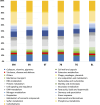Novel strains of Actinobacteria associated with neotropical social wasps (Vespidae; Polistinae, Epiponini) with antimicrobial potential for natural product discovery
- PMID: 38476864
- PMCID: PMC10929769
- DOI: 10.1093/femsmc/xtae005
Novel strains of Actinobacteria associated with neotropical social wasps (Vespidae; Polistinae, Epiponini) with antimicrobial potential for natural product discovery
Abstract
Antimicrobial resistance has been considered a public health threat. The World Health Organization has warned about the urgency of detecting new antibiotics from novel sources. Social insects could be crucial in the search for new antibiotic metabolites, as some of them survive in places that favor parasite development. Recent studies have shown the potential of social insects to produce antimicrobial metabolites (e.g. ants, bees, and termites). However, most groups of social wasps remain unstudied. Here, we explored whether Actinobacteria are associated with workers in the Neotropical Social Wasps (Epiponini) of Costa Rica and evaluated their putative inhibitory activity against other bacteria. Most isolated strains (67%) have antagonistic effects, mainly against Bacillus thuringensis and Escherichia coli ATCC 25992. Based on genome analysis, some inhibitory Actinobacteria showed biosynthetic gene clusters (BGCs) related to the production of antimicrobial molecules such as Selvamycin, Piericidin A1, and Nystatin. The Actinobacteria could be associated with social wasps to produce antimicrobial compounds. For these reasons, we speculate that Actinobacteria associated with social wasps could be a novel source of antimicrobial compounds, mainly against Gram-negative bacteria.
Keywords: actinobacteria; adults; antimicrobial compounds; inhibition; pathogen; social wasps.
© The Author(s) 2024. Published by Oxford University Press on behalf of FEMS.
Conflict of interest statement
None declared.
Figures





Similar articles
-
Draft Genome Sequences of Tsukamurella sp. 8F and 8J Strains Isolated from Social Wasps (Vespidae; Polistinae: Epiponini).Microbiol Resour Announc. 2023 Jun 20;12(6):e0023723. doi: 10.1128/mra.00237-23. Epub 2023 May 23. Microbiol Resour Announc. 2023. PMID: 37219460 Free PMC article.
-
Draft Genome Sequences of Saccharopolyspora sp. Strains and Streptomyces sp. Strains, Isolated from Social Wasps (Vespidae; Polistinae: Epiponini).Microbiol Resour Announc. 2022 Jan 20;11(1):e0093521. doi: 10.1128/MRA.00935-21. Epub 2022 Jan 6. Microbiol Resour Announc. 2022. PMID: 34989617 Free PMC article.
-
Behavioural evolution of Neotropical social wasps (Vespidae: Polistinae): the queen selection process.Cladistics. 2023 Jun;39(3):215-228. doi: 10.1111/cla.12529. Epub 2023 Mar 4. Cladistics. 2023. PMID: 36869732
-
Mutualistic Relationships between Microorganisms and Eusocial Wasps (Hymenoptera, Vespidae).Microorganisms. 2023 May 19;11(5):1340. doi: 10.3390/microorganisms11051340. Microorganisms. 2023. PMID: 37317314 Free PMC article. Review.
-
Actinobacteria Derived from Algerian Ecosystems as a Prominent Source of Antimicrobial Molecules.Antibiotics (Basel). 2019 Oct 1;8(4):172. doi: 10.3390/antibiotics8040172. Antibiotics (Basel). 2019. PMID: 31581466 Free PMC article. Review.
Cited by
-
Nest Microbial Community Dynamics Within the Nest-Building Stage of Green-Backed Tits (Parus monticolus).Ecol Evol. 2025 Sep 7;15(9):e72124. doi: 10.1002/ece3.72124. eCollection 2025 Sep. Ecol Evol. 2025. PMID: 40922999 Free PMC article.
-
Social wasp-associated Tsukamurella sp. strains showed promising biosynthetic and bioactive potential for discovery of novel compounds.Sci Rep. 2024 Sep 10;14(1):21118. doi: 10.1038/s41598-024-71969-0. Sci Rep. 2024. PMID: 39256493 Free PMC article.
References
LinkOut - more resources
Full Text Sources
